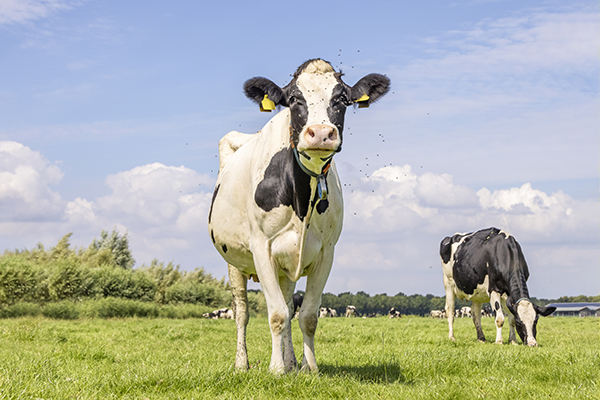Fly Control in Dairy Operations

By Jessica Graham
Flies are more than just a nuisance on dairy farms—they pose a serious threat to the profitability and well-being of the herd. These pests can lead to significant economic losses in a variety of ways. Flies reduce the rate of gain in young stock, hinder milk production, and cause discomfort and stress for the animals. This not only impacts the health of the cows but also decreases their overall productivity. As flies persist, they create an environment of constant irritation, leading to higher stress levels, reduced feed intake, and ultimately, lower milk yields. Understanding and managing fly populations is vital for every dairy.
Understand What You’re Up Against
The first step in any effective fly control program is understanding your enemy. Dairy farms are prime breeding grounds for several fly species, each with its own habits and lifecycle. House flies, those ubiquitous pests, thrive in decaying organic matter, making manure, spilled feed, and damp bedding ideal nurseries. Stable flies, similar in appearance but with a nasty bite, also breed in decaying organic material but require blood meals, making them a direct threat to cow comfort and productivity. Blow flies, larger and often metallic-colored, are attracted to decaying flesh and can be a sign of other issues on the farm. In pastures, the fly landscape changes. Horn flies, small and persistent, cluster on cattle, feeding on blood and causing significant irritation. Face flies, while not biters themselves, spread pinkeye and annoy cattle by constantly buzzing around their faces. Horse flies and deer flies, larger and more aggressive, deliver painful bites and can transmit diseases.
Understanding the fly lifecycle is crucial for targeting control efforts. Flies undergo complete metamorphosis, meaning they transform from egg to larva (maggot) to pupa to adult. The larval stage, where they feed and grow in decaying matter, is distinct from the adult stage, which focuses on reproduction and feeding (whether on sugary substances, blood, or other secretions). This difference in lifestyle means that control methods must be tailored to the specific stage.
Clean to Prevent
Beyond sanitation, mechanical control methods play a vital role. Screens on windows and doors, especially in milk rooms and parlors, can prevent flies from entering. Proper ventilation helps to keep areas dry, further reducing fly breeding opportunities. Air curtains can also be effective at preventing flies from entering certain areas.
The milking parlor requires special consideration when it comes to fly control. Sanitation is key, and Screens, proper ventilation, and light traps with glue boards can be effective in reducing fly numbers in this sensitive area.
Additionally, calf hutches, often overlooked, can be major fly breeding sites. Regular cleaning and moving of hutches to drier areas can significantly reduce fly pressure on young calves, protecting them from disease and other complications.
Feed and spilled silage can attract flies and provide them with a food source. Regularly cleaning up these materials can reduce fly populations. Proper drainage around silos and feed storage areas also helps to minimize fly breeding sites.
Implement an IPM
Effective fly control isn’t a one-size-fits-all solution. It requires an integrated pest management (IPM) approach, combining various strategies to minimize fly populations. Remember they undergo a complete metamorphosis, so there are several stages to control and eliminate the pests. At the heart of any IPM program is sanitation. Simply put, clean up! Regular removal of manure, spilled feed, and wet bedding all will help keep your barn pests under control. Even seemingly small accumulations of organic matter can harbor large fly populations.
Insecticides are probably where your mind goes first when we talk about fly control. They should be used carefully and strategically. Knockdown sprays provide a quick reduction in adult fly numbers, but their effects are often short-lived. These sprays are most effective when applied to shaded resting areas during the hottest part of the day, when flies seek cooler refuge. Residual sprays, on the other hand, leave a longer-lasting insecticide residue on surfaces, killing flies that land on them. However, these sprays are susceptible to breakdown from sunlight and rain, so they need to be applied to shaded areas and may require reapplication. They’re great and offer some residual action, but they’re not permanent, so read the label of the insecticide and apply accordingly. It’s absolutely essential to read and follow the label instructions for any insecticide, paying close attention to restrictions for lactating dairy cows and milking parlors.
Larvicides, insecticides that target the larval stage, offer a powerful way to break the fly lifecycle. They can be applied directly to manure piles and other breeding sites. Some larvicides are even available as feed-through additives, meaning they are ingested by the cattle and excreted in the manure, effectively treating breeding sites wherever the manure is deposited. Insect growth regulators (IGRs) are a special class of larvicides that disrupt the fly’s development, preventing them from reaching adulthood. These can be particularly useful in long-term fly control strategies.
Pasture fly control presents its own set of challenges. Horn flies, face flies, and other biting insects can significantly impact grazing behavior and milk production. Dust bags, strategically placed so that cattle are forced to pass under them regularly, can deliver insecticides directly to the animals Put them in high traffic areas and they’ll work well. Oilers, similar in concept, use oil as a carrier for the insecticide. Pour-on insecticides provide another option for treating individual animals, a lot of these are permethrin based. Ear tags impregnated with insecticides can offer season-long control of horn flies, but the development of insecticide resistance is a concern, so it’s important to rotate the types of ear tags used.
Manure management is a critical component of fly control. Spreading manure thinly on fields allows it to dry quickly, making it unsuitable for fly breeding. Stacked manure should be kept as dry as possible, ideally below 30% moisture. should be removed from pens and housing areas at least every ten days during fly season to disrupt the fly breeding cycle.
Finally, it’s essential to manage insecticide resistance. Rotating insecticides from different classes helps to prevent flies from developing resistance to any one product. Avoid repeated use of the same insecticide class, even if it’s applied in different ways.
Fly control is an ongoing battle, but by understanding fly biology, implementing a comprehensive IPM program, and adapting strategies as needed, dairy farmers can significantly reduce fly pressure and create a healthier and more productive environment for their cows and themselves. It’s a continuous process, requiring vigilance and a proactive approach, but the rewards – healthier cows, increased milk production, and a more pleasant working environment – are well worth the effort.

